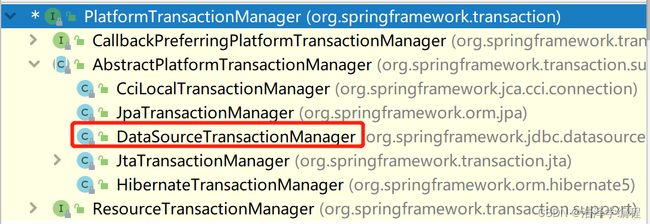Spring之事务管理
文章目录
- 前言
- 一、事务及其参数含义
-
- 1.事务的四个特性
- 2.事务的传播行为(propagation)
- 3.事务隔离性
- 4.事务的隔离级别(ioslation)
- 5.timeout(超时)
- 6.readOnly(是否只读)
- 7.rollbackFor(回滚)
- 8.noRollbackFor(不回滚)
- 二、事务管理
-
- 1.事务管理的两种形式:
- 2.注解实现声明式事务管理
- 3.xml实现声明式事务管理
- 4.完全注解开发
- 总结
前言
事务是数据库操作最基本单位,要么都成功,要么都失败。
一、事务及其参数含义
1.事务的四个特性
- 原子性
- 一致性
- 隔离性
- 持久性。
2.事务的传播行为(propagation)
Spring定义了7种传播行为:
| 传播属性 | 描述 |
|---|---|
| REQUIRED | 如果有事务在运行,当前的方法就在这个事务内运行,否则,就启动一个新的事务,并在自己的事务内运行 |
| REQUIRED_NEW | 当前的方法必须启动新事务,并在它自己的事务内运行,如果有事务正在运行,应该将它挂起 |
| SUPPORTS | 如果有事务在运行,当前的方法就在这个事务内运行,否则它可以不运行在事务中 |
| NOT_SUPPORTED | 当前方法不应该运行在事务中,如果有运行的事务,将它挂起 |
| MANDATORY | 当前的方法不应该运行在事务中,如果有运行的事务,就抛出异常 |
| NESTED | 如果有事务在运行,当前的方法就应该在这个事务的嵌套事务内运行,否则,就启动一个新的事务,并在它自己的事务内运行 |
3.事务隔离性
- 脏读:一个未提交事务读取到另一个未提交事务的数据
例:事务A读取到事务B修改后的数据,但是读取后事务B回滚了,此时A读取的是修改后的数据,但是修改撤销了。 - 不可重复读:一个未提交的事务读取到另一个提交事务修改数据
例:事务A和事务B读取同一个数据,但是事务B在读取后进行修改,然后提交,提交后事务A又读取这个数据,此时读取的是修改后的,跟上次读取的不一样。 - 幻读(虚读):一个未提交的事务读取到另一个提交事务添加数据
4.事务的隔离级别(ioslation)
5.timeout(超时)
事务在一定时间内进行提交,如果不提交会进行回滚,默认值是-1,设置时间以秒为单位进行计算。
6.readOnly(是否只读)
读:查询,写:增删改
默认值是false,表示可以增删改查,设置true后只能查询。
7.rollbackFor(回滚)
设置出现哪些异常进行事务回滚。
8.noRollbackFor(不回滚)
设置出现哪些异常不进行事务回滚。
二、事务管理
Spring事务管理提供了一个接口,叫做事务管理器,这个接口针对不同的框架提供不同的实现类。

1.事务管理的两种形式:
- 编程式事务管理
例:
try{
//开启事务
//进行业务操作
userDao.reduceMoney();
//模拟异常
int i=10/0;
userDao.addMoney();
//没出现异常,事务提交
}catch (Exception e){
//异常,事务回滚
}
- 声明式事务管理(AOP原理)
例:
@Service
@Transactional(timeout = -1,propagation = Propagation.REQUIRED,isolation = Isolation.READ_COMMITTED)
public class UserService{
@Autowired
private UserDao userDao;
public void accountMoney(){
userDao.reduceMoney();
int i= 1 / 0;
userDao.addMoney();
}
}
2.注解实现声明式事务管理
就是上述声明式管理的例子,这里补充一下全部代码:
================userDao====================
package com.dragon.shiwu.dao;
public interface UserDao {
public void addMoney();
public void reduceMoney();
}
==============userDaoImpl===================
package com.dragon.shiwu.dao;
import org.springframework.beans.factory.annotation.Autowired;
import org.springframework.jdbc.core.JdbcTemplate;
import org.springframework.stereotype.Repository;
@Repository
public class UserDaoImpl implements UserDao{
@Autowired
private JdbcTemplate jdbcTemplate;
@Override
public void addMoney() {
String sql="update t_account set money=money + ? where username = ?";
jdbcTemplate.update(sql,100,"mary");
}
@Override
public void reduceMoney() {
String sql="update t_account set money=money-? where username=?";
jdbcTemplate.update(sql,100,"lucy");
}
}
==============userService============================
package com.dragon.shiwu.service;
import com.dragon.shiwu.dao.UserDao;
import org.springframework.beans.factory.annotation.Autowired;
import org.springframework.stereotype.Service;
import org.springframework.transaction.annotation.Isolation;
import org.springframework.transaction.annotation.Propagation;
import org.springframework.transaction.annotation.Transactional;
@Service
@Transactional(timeout = -1,propagation = Propagation.REQUIRED,isolation = Isolation.READ_COMMITTED)
public class UserService{
@Autowired
private UserDao userDao;
public void accountMoney(){
userDao.reduceMoney();
int i= 1 / 0;
userDao.addMoney();
}
}
============Spring配置文件===========================(注意这里引入了tx命名空间和)
<?xml version="1.0" encoding="UTF-8"?>
<beans xmlns="http://www.springframework.org/schema/beans"
xmlns:xsi="http://www.w3.org/2001/XMLSchema-instance"
xmlns:context="http://www.springframework.org/schema/context"
xmlns:tx="http://www.springframework.org/schema/tx"
xsi:schemaLocation="http://www.springframework.org/schema/beans http://www.springframework.org/schema/beans/spring-beans.xsd
http://www.springframework.org/schema/context http://www.springframework.org/schema/context/spring-context.xsd
http://www.springframework.org/schema/tx http://www.springframework.org/schema/tx/spring-tx.xsd">
<context:property-placeholder location="classpath:jdbc.properties"/>
<bean id="dataSource" class="com.alibaba.druid.pool.DruidDataSource">
<property name="driverClassName" value="${pro.driverClass}"></property>
<property name="url" value="${pro.url}"></property>
<property name="username" value="${pro.username}"></property>
<property name="password" value="${pro.password}"></property>
</bean>
<!--创建JdbcTemplate对象-->
<bean id="jdbcTemplate" class="org.springframework.jdbc.core.JdbcTemplate">
<!--注入数据库连接池-->
<property name="dataSource" ref="dataSource"></property>
</bean>
<context:component-scan base-package="com.dragon.shiwu"></context:component-scan>
<!--创建事务管理器-->
<bean id="transactionManager" class="org.springframework.jdbc.datasource.DataSourceTransactionManager">
<property name="dataSource" ref="dataSource"></property>
</bean>
<!-- 开启事务注解-->
<tx:annotation-driven transaction-manager="transactionManager"></tx:annotation-driven>
</beans>
3.xml实现声明式事务管理
Spring配置文件:
<?xml version="1.0" encoding="UTF-8"?>
<beans xmlns="http://www.springframework.org/schema/beans"
xmlns:xsi="http://www.w3.org/2001/XMLSchema-instance"
xmlns:context="http://www.springframework.org/schema/context"
xmlns:tx="http://www.springframework.org/schema/tx"
xmlns:aop="http://www.springframework.org/schema/aop"
xsi:schemaLocation="http://www.springframework.org/schema/beans http://www.springframework.org/schema/beans/spring-beans.xsd
http://www.springframework.org/schema/context http://www.springframework.org/schema/context/spring-context.xsd
http://www.springframework.org/schema/tx http://www.springframework.org/schema/tx/spring-tx.xsd
http://www.springframework.org/schema/aop http://www.springframework.org/schema/aop/spring-aop.xsd">
<context:property-placeholder location="classpath:jdbc.properties"/>
<bean id="dataSource" class="com.alibaba.druid.pool.DruidDataSource">
<property name="driverClassName" value="${pro.driverClass}"></property>
<property name="url" value="${pro.url}"></property>
<property name="username" value="${pro.username}"></property>
<property name="password" value="${pro.password}"></property>
</bean>
<bean id="jdbcTemplate" class="org.springframework.jdbc.core.JdbcTemplate">
<property name="dataSource" ref="dataSource"></property>
</bean>
<!-- 开启组件扫描-->
<context:component-scan base-package="com.dragon.shiwu"></context:component-scan>
<!--配置事务通知-->
<tx:advice id="txadvice">
<tx:attributes>
<!--配置事务参数-->
<tx:method name="accountMoney" propagation="REQUIRED"/>
</tx:attributes>
</tx:advice>
<!-- 配置切入点和切面-->
<aop:config>
<!-- 配置切入点-->
<aop:pointcut id="pt" expression="execution(* com.dragon.shiwu.service.UserService.*(..))"/>
<!-- 配置切面-->
<aop:advisor advice-ref="txadvice" pointcut-ref="pt"></aop:advisor>
</aop:config>
</beans>
4.完全注解开发
TxConfig类:
package com.dragon.shiwu.config;
import com.alibaba.druid.pool.DruidDataSource;
import org.springframework.context.annotation.Bean;
import org.springframework.context.annotation.ComponentScan;
import org.springframework.context.annotation.Configuration;
import org.springframework.jdbc.core.JdbcTemplate;
import org.springframework.jdbc.datasource.DataSourceTransactionManager;
import org.springframework.transaction.annotation.EnableTransactionManagement;
import javax.sql.DataSource;
@Configuration//配置类
@ComponentScan(basePackages = "com.dragon.shiwu")//组件扫描
@EnableTransactionManagement//开启事务
public class TxConfig {
//创建数据库连接池
@Bean
public DruidDataSource getDruidDataSource(){
DruidDataSource druidDataSource = new DruidDataSource();
druidDataSource.setDriverClassName("com.mysql.cj.jdbc.Driver");
druidDataSource.setUrl("jdbc:mysql://localhost:3306/user_db");
druidDataSource.setUsername("root");
druidDataSource.setPassword("root");
return druidDataSource;
}
//创建JdbcTemplate对象
@Bean
public JdbcTemplate getJdbcTemplate(DataSource dataSource){
JdbcTemplate jdbcTemplate = new JdbcTemplate();
jdbcTemplate.setDataSource(dataSource);
return jdbcTemplate;
}
//创建事务管理器
@Bean
public DataSourceTransactionManager getDataSourceTransactionManager(DataSource dataSource){
DataSourceTransactionManager transactionManager = new DataSourceTransactionManager();
transactionManager.setDataSource(dataSource);
return transactionManager;
}
}
测试类:
package com.dragon.shiwu.test;
import com.dragon.shiwu.config.TxConfig;
import com.dragon.shiwu.service.UserService;
import org.springframework.context.ApplicationContext;
import org.springframework.context.annotation.AnnotationConfigApplicationContext;
public class test2 {
public static void main(String[] args) {
ApplicationContext context=new AnnotationConfigApplicationContext(TxConfig.class);
UserService userService = context.getBean("userService",UserService.class);
userService.accountMoney();
}
}
总结
以上就是Spring事务管理的讲解。




